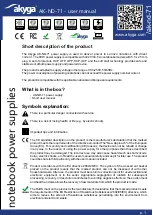
Page 95
EPS Stromversorgung GmbH
Alter Postweg 101 • 86159 Augsburg
Germany
Fon: +49 821 / 570451-0
Fax: +49 821 / 570451-25
www.eps-germany.de
PSI 10000 4U Serie
4.3
Calibration
4.3.1
Preface
The devices of series PSI 10000 don’t have a built- in feature to re-adjust the most important DC output related
values, but they can still be readjusted using the software
EPS
Power Control. The required calibration app is
included in the free of charge base version of this software. In order to use the feature is may be necessary to
install a n update of this software.
Re-adjustment is intended to compensate small deviations of the output related values of voltage and current in a
range of up to 1% or 2% of the rated value. There are several reasons which could make it necessary to re-adjust
a unit: component aging, component deterioration, extreme ambient conditions, high frequent use.
In order to determine if a value is out of tolerance, the parameter must first be verified with measurement tools of
high accuracy and with at least half the error of the PSI device. Only then a comparison between values displayed
on the PSI device and true DC output values is possible.
For example, if you want to verify and possibly readjust the output current of model PSI 10080-1000 4U which has
1000 A maximum current, stated with a max. error of 0.1%, you can only do that by using a high current shunt or
current transducer with max. 0.05% error or less. Also, when measuring such high currents, it’s recommended to
keep the process short, in order to avoid the shunt heating up too much. It’s furthermore recommended to use a
shunt with at least 25% reserve.
When measuring the current with a shunt, the measurement error of the multimeter on the shunt adds to the error
of the shunt and the sum of both must not exceed the max. error of the device under calibration.
4.3.2
Preparation
For a successful calibration and readjustment, a few tools and certain ambient conditions are required:
•
A measurement device (multimeter) for voltage, with a max. error of half the PSI’s voltage error. That measure
-
ment device can also be used to measure the shunt voltage when readjusting the current
•
If the current is also going to be calibrated: a suitable DC current shunt, ideally specified for at least 1.25 times
the max. output current of the PSI and with a max. error that is half or less than the max. current error of the PSI
device to calibrate
•
Normal ambient temperature of approx. 20-25°C
•
Warmed up PSI unit, which has been run for at least 10 minutes under 50% power
•
One or two adjustable loads, preferably electronic ones, which are capable of consuming at least 102% of the
max. voltage and current of the PSI device and which are calibrated and precise
Before you can start calibrating, a few measures have to be taken:
•
Let the PSI device warm up for at least 10 minutes under 50% load, in connection with the voltage / current source
•
In case the remote sensing input is going to be calibrated, prepare a cable for the remote sensing connector to
DC output, but leave it yet unconnected
•
Abort any form of remote control, deactivate master-slave mode, deactivate resistance mode
•
Install the shunt between PSI device and load and make sure the shunt is cooled somehow
•
Connect external measurement devices to the DC output and/or to the shunt/transducer, depending on whether
the voltage is going to be calibrated first or the current
4.3.3
Calibration procedure
The re-adjustment is done in the graphical user interface of EPS
Power Control. The software will guide through
the process with instructions, as far as possible. The user manual of the software holds additional information.




































